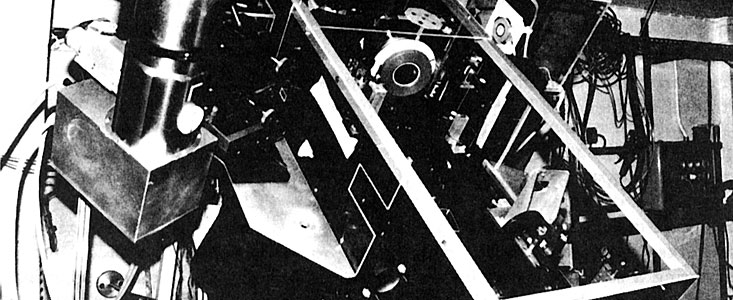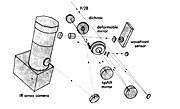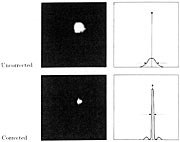Pressemitteilung
Catching a Twinkling Star: Successful Tests of Adaptive Optics Herald New Era
26. Oktober 1989
An old dream of ground-based astronomers has finally come true, thanks to the joint development of a revolutionary new technique, adaptive optics, by ESO and ONERA [1], LdM [2] and Observatoire de Paris in France.
It effectively eliminates the adverse influence of atmospheric turbulence on images of astronomical objects, yielding images almost as sharp as if the telescope were situated in space. An editorial appraisal of this important break-through appears in today's issue of the scientific journal Nature.
Why adaptive optics?
Ever since the invention of the telescope in the early 17th century, astronomers have had to accept that the sharpness of astronomical images obtained with ground-based instruments is severely limited by a factor which is beyond their control, that is the turbulence in the Earth's atmosphere.
This turbulence is perceived by the eye as the twinkling of stars. High above the observer, mostly at altitudes between 5 and 10 kilometres, there are many small, moving cells of air, each of which produces a "sub-image" of the same star; the result is a swarm of moving sub-images. (Compare with the air above a toaster or a hot radiator.)
To a naked-eye observer, the number of sub-images which fall within the periphery of his eye pupil changes all the time. The perceived intensity of the star varies; the star twinkles.
In a telescope, the size (that is, the sharpness) of a stellar image, is equal to the area within which this swarm of sub-images moves. The greater the air turbulence, the larger is this area and the less sharp are the resulting images. Because of this effect, an increase of the size of a telescope does not improve its ability to resolve details of astronomical objects, once the aperture of the telescope exceeds 10 or 20 cm; the best achievable image sharpness, even by high-quality, large astronomical telescopes, is effectively determined by the state of the atmosphere, and is referred to as "astronomical seeing" during the exposure. For this reason, large telescopes are placed at sites where the atmospheric turbulence is as small as possible, for instance La Silla.
For a long time it was thought impossible to avoid this natural limit. Now, for the first time, this old problem has been demonstrably solved.
A break-through in optical technology
In a major technological break-through in ground-based astronomy, a new device, known as the VLT Adaptive Optics Prototype (see eso8717, eso8808, and eso8707), has now proved its ability to overcome this natural barrier during a series of successful tests in the period 12 - 23 October 1989. They were performed at the coudé focus of the 1.52 m telescope at the Observatoire de Haute Provence (OHP), France (see photo).
The extensive tests showed that it was possible effectively to “neutralize'' the atmospherically induced smearing of a stellar image by continuously monitoring the motion of the sharp sub-images and then focussing them into one spot by means of a deformable mirror. In this way stellar images were obtained at infrared wavelengths whose sharpness was only limited by the telescope aperture (this is referred to as diffraction limited imaging).
On each of ten nights, exposures were made of about 10 bright stars through 4 or 5 infrared filters. Several integrations were made through each filter without the adaptive device, immediately followed by an equal number with the device activated. Depending on the brightness of the observed star, each exposure lasted between 10 and 100 seconds. For wavelengths of 3.5 μm and longer, the diffraction limit was always reached, irrespective of the atmospheric turbulence; it was often reached at 2.2 μm (see the figure) and a noticeable improvement was seen at 1.2 μm.
How does it work ?
The adaptive optics technique can also be described in terms of correcting the atmospherically introduced distortions of the light wavefront from the star.
It is based on a feed-back loop, and the optical system contains a deformable mirror which can change its surface profile in a way that exactly compensates for the distortions of the light wavefront after it has passed through the atmosphere. The information about how to deform the mirror comes from a wavefront sensor which allows to measure the shape of the distorted light wavefront. It requires a very fast and powerful computer to calculate how the actuators located behind the deformable mirror have to push and pull the mirror surface.
The present prototype system has a mirror with 19 actuators. The mirror is deformed, hence the wavefront is corrected, 100 times per second.
Future plans
This prototype system will soon be installed at the ESO 3.6 m telescope at La Silla. The encouraging results represent a first, major step on the way towards an adaptive system for the 16 m Very Large Telescope (VLT).
The new technology makes it possible to achieve the theoretical limits for optical imaging in the infrared wavelength range by means of a medium-sized telescope. Further developments will aim at perfecting the technique for larger telescopes and at shorter wavelengths. Not only will present day telescopes benefit, but this technique will revolutionize the exploitation of the next generation telescopes, such as the ESO VLT, and, in many cases, compete with observations carried out by telescopes deployed in space.
Note that the technique of adaptive optics, as described here, is complementary to active optics, a system that allows to keep large astronomical mirrors in optimal shape when gravity, wind and heat distort them, and which has recently been successfully installed at the ESO New Technology Telescope (eso8903).
Endnoten
[1] Office National d'Etudes et de Recherches Aérospatiale.
[2] Laboratoires de Marcoussis (formerly CGE, now Aérospatiale).
Weitere Informationen
A scientific-technical paper, describing the first adaptive optics results, is expected to appear soon in the European journal Astronomy & Astrophysics.
Acknowledgements
The design and construction of this system is the product of a three year effort, involving a collaboration between the European Southern Observatory (ESO), the Office National d'Etudes et de Recherches Aérospatiales, the Laboratories de Marcoussis (formerly CGE, now Aérospatiale) and the Observatoire de Paris.
The project received support from ESO, the Ministère de la Recherche et de la Technologie (France), Ministère de l'Education Nationale, Direction de la Recherche (France), Université Paris VII, Centre National de la Recherche Scientifique (CNRS) and Institut National des Sciences de l'Univers (INSU).
The early development of critical optical components of the system has been independently supported by La Direction des Recherches et Etudes Techniques (DRET), Ministère de la Défense, France.
Kontaktinformationen
Richard West
ESO
Garching, Germany
Tel: +49 89 3200 6276
E-Mail: information@eso.org
Über die Pressemitteilung
| Pressemitteilung Nr.: | eso8908 |
| Legacy ID: | PR 06/89 |
| Name: | Adaptive Optics, Deneb, Instrumentation, Very Large Telescope |
| Typ: | Unspecified : Technology : Observatory : Instrument |
| Facility: | Very Large Telescope |
Our use of Cookies
We use cookies that are essential for accessing our websites and using our services. We also use cookies to analyse, measure and improve our websites’ performance, to enable content sharing via social media and to display media content hosted on third-party platforms.
ESO Cookies Policy
The European Organisation for Astronomical Research in the Southern Hemisphere (ESO) is the pre-eminent intergovernmental science and technology organisation in astronomy. It carries out an ambitious programme focused on the design, construction and operation of powerful ground-based observing facilities for astronomy.
This Cookies Policy is intended to provide clarity by outlining the cookies used on the ESO public websites, their functions, the options you have for controlling them, and the ways you can contact us for additional details.
What are cookies?
Cookies are small pieces of data stored on your device by websites you visit. They serve various purposes, such as remembering login credentials and preferences and enhance your browsing experience.
Categories of cookies we use
Essential cookies (always active): These cookies are strictly necessary for the proper functioning of our website. Without these cookies, the website cannot operate correctly, and certain services, such as logging in or accessing secure areas, may not be available; because they are essential for the website’s operation, they cannot be disabled.
Functional Cookies: These cookies enhance your browsing experience by enabling additional features and personalization, such as remembering your preferences and settings. While not strictly necessary for the website to function, they improve usability and convenience; these cookies are only placed if you provide your consent.
Analytics cookies: These cookies collect information about how visitors interact with our website, such as which pages are visited most often and how users navigate the site. This data helps us improve website performance, optimize content, and enhance the user experience; these cookies are only placed if you provide your consent. We use the following analytics cookies.
Matomo Cookies:
This website uses Matomo (formerly Piwik), an open source software which enables the statistical analysis of website visits. Matomo uses cookies (text files) which are saved on your computer and which allow us to analyze how you use our website. The website user information generated by the cookies will only be saved on the servers of our IT Department. We use this information to analyze www.eso.org visits and to prepare reports on website activities. These data will not be disclosed to third parties.
On behalf of ESO, Matomo will use this information for the purpose of evaluating your use of the website, compiling reports on website activity and providing other services relating to website activity and internet usage.
Matomo cookies settings:
Additional Third-party cookies on ESO websites: some of our pages display content from external providers, e.g. YouTube.
Such third-party services are outside of ESO control and may, at any time, change their terms of service, use of cookies, etc.
YouTube: Some videos on the ESO website are embedded from ESO’s official YouTube channel. We have enabled YouTube’s privacy-enhanced mode, meaning that no cookies are set unless the user actively clicks on the video to play it. Additionally, in this mode, YouTube does not store any personally identifiable cookie data for embedded video playbacks. For more details, please refer to YouTube’s embedding videos information page.
Cookies can also be classified based on the following elements.
Regarding the domain, there are:
- First-party cookies, set by the website you are currently visiting. They are stored by the same domain that you are browsing and are used to enhance your experience on that site;
- Third-party cookies, set by a domain other than the one you are currently visiting.
As for their duration, cookies can be:
- Browser-session cookies, which are deleted when the user closes the browser;
- Stored cookies, which stay on the user's device for a predetermined period of time.
How to manage cookies
Cookie settings: You can modify your cookie choices for the ESO webpages at any time by clicking on the link Cookie settings at the bottom of any page.
In your browser: If you wish to delete cookies or instruct your browser to delete or block cookies by default, please visit the help pages of your browser:
Please be aware that if you delete or decline cookies, certain functionalities of our website may be not be available and your browsing experience may be affected.
You can set most browsers to prevent any cookies being placed on your device, but you may then have to manually adjust some preferences every time you visit a site/page. And some services and functionalities may not work properly at all (e.g. profile logging-in, shop check out).
Updates to the ESO Cookies Policy
The ESO Cookies Policy may be subject to future updates, which will be made available on this page.
Additional information
For any queries related to cookies, please contact: pdprATesoDOTorg.
As ESO public webpages are managed by our Department of Communication, your questions will be dealt with the support of the said Department.



